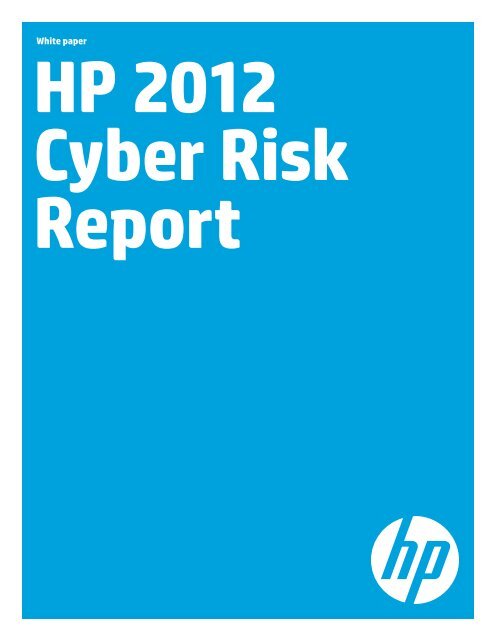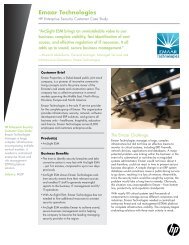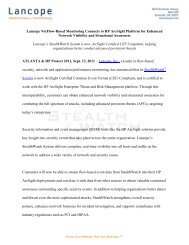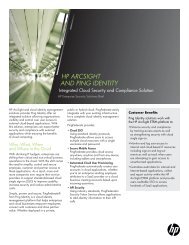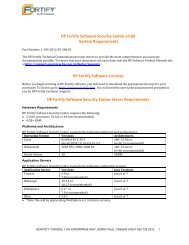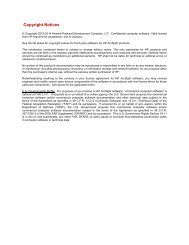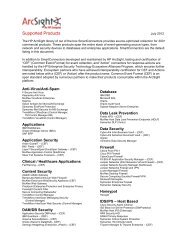HP 2012 Cyber Risk Report
HP 2012 Cyber Risk Report
HP 2012 Cyber Risk Report
- No tags were found...
Create successful ePaper yourself
Turn your PDF publications into a flip-book with our unique Google optimized e-Paper software.
White paper | <strong>HP</strong> <strong>2012</strong> <strong>Cyber</strong> <strong>Risk</strong> <strong>Report</strong>According to OSVDB data, only 76 vulnerabilities were disclosed in SCADA systems from2008 through 2010. However, after the Stuxnet worm was discovered in an Iranian uraniumenrichment plant in 2010, much attention has been focused on the security of SCADA systems.In 2011, there were 164 vulnerabilities disclosed in SCADA systems, and the number rose againto 191 in <strong>2012</strong>, representing a 768 percent increase from 2008 numbers (see Figure 7).Figure 7. Disclosed SCADA vulnerabilities measured by OSVDB, 2008–<strong>2012</strong>2502001501005002008 2009 2010 2011 <strong>2012</strong>Zero Day Initiative: a glance at <strong>2012</strong>Due to the ZDI’s position as the premiere vulnerability acquisition program, the team’s researchers oftenhave the opportunity to analyze some of the most interesting and talked-about vulnerabilities that haveoccurred over the past year. The following <strong>2012</strong> “buzz-worthy” cases illustrate the intersection betweenwhite and black markets.At the beginning of <strong>2012</strong>, a vulnerability in the Microsoft® Remote Desktop (ZDI-12-044, MS12-020, andCVE-<strong>2012</strong>-0002) received extensive attention:• The ZDI reported this specific flaw to Microsoft in August 2011.• There were no known attacks in the wild; however, due to its attractiveness to attackers, Microsoftexpected exploitation to be imminent by March <strong>2012</strong>.• This flaw was potentially reachable over the network before authentication was required and existedduring error handling while elements were being loaded into an array.Only a month later, Samba released a much-needed patch based on a flaw found by a ZDI researcher(TPTI-12-04, CVE-<strong>2012</strong>-1182):• The ZDI reported this specific flaw to Samba in September 2011.• There were no known attacks in the wild; however, as this is the most serious vulnerability possible in aprogram, Samba addressed it quickly.• This flaw did not require an authenticated connection and resulted in memory corruption that may beexploited by an attacker to gain remote code execution.The end of <strong>2012</strong> brought a flurry of zero-day activity affecting both Oracle (CVE-<strong>2012</strong>-0422,CVE-<strong>2012</strong>-3174) and Microsoft (MS13-008, CVE-<strong>2012</strong>-4792). The ZDI was at the forefront of theaction, having reported a critical Java vulnerability patched with the zero-day activity:• The ZDI reported this Java flaw to Oracle in December <strong>2012</strong>.• This flaw was exploited in the wild.• This flaw allowed a malicious applet to execute attacker-supplied code, resulting in remote codeexecution under the context of the current user.These are only a few cases handled by the ZDI in <strong>2012</strong> that illustrate the intersection between white andblack markets in the vulnerability arms race. One thing is certain: our researchers are in the race to find andresponsibly disclose vulnerabilities in highly prevalent software technology.8
White paper | <strong>HP</strong> <strong>2012</strong> <strong>Cyber</strong> <strong>Risk</strong> <strong>Report</strong>Web application vulnerabilitiesTo develop a more complete picture of the current vulnerability landscape, the <strong>HP</strong> Fortify onDemand team gathered and analyzed the results of thousands of assessments to see howWeb application security looks from the inside via code review and penetration testing. Athorough review of both static (examining source code for vulnerabilities without executingit) and dynamic (testing the running software as an attacker would without access to thecode itself) analysis results provides a sound basis for investigating the true state of risk inWeb applications.The sample sets used for this analysis comprised over 200 randomly selected applicationsfor dynamic analysis and 800 applications for static analysis. Figure 8 shows the top fivevulnerabilities discovered using dynamic analysis in <strong>2012</strong>.Figure 8. Top five vulnerabilities discovered with dynamic analysis in <strong>2012</strong> via <strong>HP</strong> Fortify on Demand50%45%45%40%35%30%25%26% 25%20%15%10%13%9%5%0%Cross-site scriptingInsufficienttransport layerprotectionSecuritymisconfigurationBrokenauthenticationand sessionmanagementInjection flawsThe dynamic results from this sample set as well as other results referenced in this reportshow that cross-site scripting attacks remain a major threat when attempting to secure Webapplications. Considering that the number one vulnerability type purchased last year by ZDI wascross-site scripting, and that repeated testing verifies how widespread cross-site scripting is,organizations have sufficient reason to consider this a primary security concern.Figure 9 shows how a typical cross-site scripting attack works, as well as how it can beleveraged to steal authentication credentials on critical sites.9
White paper | <strong>HP</strong> <strong>2012</strong> <strong>Cyber</strong> <strong>Risk</strong> <strong>Report</strong>Figure 9. Breakdown of a reflected cross-site scripting attackBanking site2. The attacker creates an attack URLfor stealing sensitive informationand disguises it so that it appearslegitimate.1. An attacker finds an XSShole in a Web application.3. The attacker distributesthe malicious XSS link viasocial engineering tounsuspecting users.Evilattacker4. When the victim logs in,JavaScript, which is embeddedwith the malicious XSS link,executes and transmits thevictim’s login information tothe attacker.UnsuspectinguserFigure 10 shows the top five vulnerabilities discovered with static analysis in <strong>2012</strong>, and includesthe relative percentage of applications impacted by each vulnerability category.Figure 10. Top five vulnerabilities discovered with static analysis in <strong>2012</strong> via <strong>HP</strong> Fortify on Demand100%90%80%92%88% 86%75%70%60%61%50%40%30%20%10%0%Informationleakage andimpropererror handlingInsecurecryptographicstorageInjection flawsInsecure directobject referenceBrokenauthenticationand sessionmanagementThe static results reveal that information leakage, problems with cryptographic storage, andinjections flaws were all heavily represented. Not revealed in the top five results is the factthat reflected cross-site scripting (as illustrated in Figure 9) was returned in 51 percent of theapplications. While not in the top five, that’s still significant when combined with the otherfinding of this report.Evidence from both sample sets leaves little doubt that Web applications continue to beplagued by weaknesses deemed critical by various industry standards. The top five vulnerabilitycategories that dominate the findings are often responsible for exposing Web applications tosevere risks like information theft, privilege escalation, and so on. Both these data sets lead usto conclude that organizations continue to fail in applying consistent remediation to ubiquitousvulnerabilities such as cross-site scripting and information leakage.10
White paper | <strong>HP</strong> <strong>2012</strong> <strong>Cyber</strong> <strong>Risk</strong> <strong>Report</strong>Also worth noting is that the most prolific vulnerability used by attackers in conjunction withother known vulnerabilities is information leakage. While a specific piece of information mightnot seem important, it might be the one key component that allows an attacker to escalate atechnique and conduct a more devastating attack. At the end of the day, a successful attack isprepared through careful information gathering and reconnaissance techniques.Web application risk: a case studyCompany profileLarge (more than 100,000 employees) multinational organization with revenues exceeding $82 billion USDfor FY<strong>2012</strong>This company has an active security program in place. The findings indicate how much diligence it takesto fully manage application security risk. The following results are from over 1,300 unique dynamicassessments conducted against various sites the company maintains. In the modern application securityera, one vulnerability can often be too many.The results:• 54.1 percent of the assessments revealed persistent cookies. The European Network and InformationSecurity Agency (ENISA) has referred to these as “bittersweet” cookies. Persistent cookies greatlyincrease the probability that replay attacks will occur because of the lengthened time cookies remainvalid. Information disclosure at “shared” kiosks, etc., can also produce persistent cookies. Because theseare used to track behavior, and so on, it’s likely that security considerations were somewhat outweighedby the cookies’ potential “benefit” to the corporation.• Just under half (48.32 percent) of the sites were vulnerable to some form of cross-site scripting.• Almost one-fifth (19.57 percent) of the sites contained a “mixed-scheme” unencrypted login form whereinformation from an HTTP page was posted to an HTTPS page or vice versa.• 12.77 percent of the assessments were vulnerable to some form of SQL injection. What was reallyintriguing is that 10.97 percent of the assessments confirmed blind SQL injection vulnerabilities.Considering how particularly nasty blind SQL injection is and that even one such vulnerability can often beused to compromise a system, this percentage is very dangerous.• Another fifth (19.7 percent) of sites were vulnerable to logins sent over an unencrypted connection. Thismeans that the form did not utilize SSL.• 5.26 percent of sites were susceptible to local file inclusion/read vulnerabilities. If sensitive enough, thecontents of the file could be used to take control of the system.Devastating attacksIn addition to statistics, security intelligence also requires observation and insight. To thatend, the following section summarizes a list of devastating attacks that <strong>HP</strong> Fortify on Demandpenetration testers discovered in the wild during <strong>2012</strong>. Every account was discovered withpermission during approved engagements against production sites ranging in technical acuityfrom trivial to challenging. The common thread among them was that all of the attacks hadextremely serious consequences if discovered by a malicious attacker. The customer nameshave not been included for obvious reasons, but the industries themselves are listed in orderto illustrate the danger and relevance of the attacks. While these examples are anecdotal innature, they do take advantage of the experience and opinions of our penetration testers in away that simple statistics do not. As always, security is more than just products. It’s a process.Injection and improper input validation hacksIndustries: petrochemical, food processing, energy, and softwareUnsafe file uploads and security misconfiguration: A thick client program allowed anyuser to upload malware via its upload function to a Web server that had no anti-malwareprotection. The program had about 30,000 users worldwide, so this was particularly dangerous.Obviously, it is imperative that file upload functionality exercise extreme prejudice with regardto acceptable file types. Figure 11 shows the consequences of this scenario.11
White paper | <strong>HP</strong> <strong>2012</strong> <strong>Cyber</strong> <strong>Risk</strong> <strong>Report</strong>Figure 11. Allowing unvalidated user uploads can have severe consequencesUnvalidateduseruploadsNo antimalwareprotectionInfect30,000users withmalwareFigure 12. Blind SQL InjectionSystemadministrationaccessBlind SQL injection: Guided search functionality (a series of checkboxes designed to helpconsumers narrow down their search criteria) without input validation resulted in the exposureof 35 databases and database system user IDs and password hashes, including the systemadministrator account. Blind SQL injection can be difficult to find because it rarely reveals errormessages and manifests itself as anomalous application behavior. Parameterized queries,also known as prepared statements, effectively prevent SQL injection attacks when properlyimplemented. 5 Figure 12 shows this sequence.Blind SQLinjectionUserinformationtheftCleartext SQL: During testing of a thick client application, it was discovered that the clientwas executing SQL statements directly to the back-end SQL server with administrator-levelpermissions over HTTP. By reverse engineering the protocol and through manipulation, userprivilege escalation and password modification was achieved (see Figure 13).Figure 13. Cleartext SQLPasswordreset usingelevatedprivilegeReverse engineerclient/serverprotocolSQL executionFigure 14. Failure to restrict accessUnrestricted directory accesshttps://www.example.com/passwords/ {Directory}passwrds.projectpasswords.systems {File}user:passwordsysadmin:{password}Local file inclusion: Directory traversal and local file inclusion techniques were used to viewthe contents of the Web server’s backup security accounts manager (SAM) file, which allowedthe passwords to be cracked. Within 10 minutes, local administrator access to the system wasgained, allowing for complete compromise. Input validation routines, both inherent within theapplication and at the Web server configuration level, would have eliminated this vector.Security misconfiguration hacksIndustries: petrochemical and international bankingFailure to restrict access to sensitive directories: In this case, the discovered directory was“https://www.example.com/passwords/”. Understandably, there shouldn’t be a “passwords”folder, at least not publicly. The folder was accessible via Web browsers with no authenticationand included a directory listing of text files with names like “passwords.project”, including“passwords.systems”. Clicking on a file opened a text document with a list of users andpasswords in the format: user:password. One of the lists even contained “sysadmin:{password}admin:{password} etc…” (see Figure 14). This illustrates the need for and the importanceof post-automated scan validation, as this seemingly low-risk vulnerability could easily bedisregarded by the customer. In addition, the problem could have been avoided if access to thedirectory had been properly restricted.WebDAV enabled allowing remote write: WebDAV was enabled on a particular Web server ina way that allowed remote application users to interact with the host and write files to arbitrarydirectories. By leveraging this vulnerability, a custom backdoor was uploaded and subsequentlyexecuted by browsing to the URL path of the newly transferred file. Once executed, it allowedfull control of the Web server. If scoped for further testing, the tester would have been able tocontinue the attack against other hosts on the internal corporate network—a process knownas pivoting. Removing WebDAV access and extraneous HTTP methods could have preventedthis attack.SQL injection and weak input validation controls: A SQL filter was filtering everything butthe “OR” operator. This basically means that by including “OR” in a SQL statement that anycommand after it would be executed on the system. Parameterizing queries will prevent SQLinjection attacks. Figure 15 breaks down the sequence of a SQL injection attack.5 https://www.owasp.org/index.php/SQL_Injection_Prevention_Cheat_Sheet12
White paper | <strong>HP</strong> <strong>2012</strong> <strong>Cyber</strong> <strong>Risk</strong> <strong>Report</strong>Figure 15. Breakdown of a SQL injection attackBanking site3. Once the database schema hasbeen defined, the attacker canthen extract whatever data thedatabase contains, includinguser names, passwords, creditcard information, etc.Bank database1=1 ?2. Via trial and error, theattacker can constructSQL arguments that canbe used to retrieve datasuch as table names, rownames, etc.1. An attacker submits“extra” information,such as a single quotationmark or “1=1” with a login,or other input variableto alter the original SQLstatement.Evil attackerSAP misconfiguration: The entire credit card database was accessed and dumped to a file. TheSAP implementation had poorly configured controls, allowing customer service representativesto run sensitive transactions, including the HR data browser (SE16). This capability was used tobrowse and load the entire contents of the customer credit card data table. Given access in thismanner, the entire data set could easily be exported using lowest-privilege SAP accounts.Authentication, session, logic, and miscellaneous hacksIndustries: airline, international banking, and energyEnumeration of airline tickets through mobile QR code Web services: Testers were able toreverse engineer part of the Web service function to create ticket numbers. Fake ticket QR codesfor airline flights were then generated. Hypothetically speaking, exploitation may have enabledattackers to fly for free by allowing them to check in via their mobile devices in the absence ofeffective compensating controls. Using an industry-standard randomization function for ticketnumbers could also have prevented this problem.Figure 16. Easily reversible dynamic password generationAuthWebserviceSQLattackDisablepasswordencryptionInsufficientpasswordrandomizationAdminaccess to DBEncrypted trafficcaptureDisable encryption -guess passwordFull database accesswith admin permissions13
White paper | <strong>HP</strong> <strong>2012</strong> <strong>Cyber</strong> <strong>Risk</strong> <strong>Report</strong>Easily reversible dynamic password generation: The thick client application being testedcommunicated with a Web service that first authenticated the user attempting to log in. Next,the application requested the password to the back-end database server. The password wasoriginally encrypted during transmission, but by combining another SQL attack, a flag in thedatabase was able to be flipped, and thereby turn off this encryption. It appeared the systemimplemented dynamic passwords that changed frequently; however, after gathering multiplepasswords, a pattern emerged. The password was time based and therefore easily guessable.Direct access to the database with administrative permissions was confirmed, allowing forcomplete compromise of the system (see Figure 16).Web service allowed direct SQL queries: An application allowed connections to its backenddatabase via a Web-based interpreter that was accessible to the Internet withoutauthentication. With limited knowledge of SQL, an attacker could easily retrieve all recordsin the client database, including full user account details: user names, passwords, and emailaddresses, among other personally identifiable information (PII).By sharing these accounts of real-world penetration testing findings, our goal is to drawattention to the limitless creativity and endless determination of malicious attackers.Penetration testers emulate these techniques in an effort to effectively test each securitycontrol to help ensure that sensitive data and application capabilities are protected. Asdemonstrated in these accounts, automated security testing alone is an incomplete measure ofan environment’s overall security posture and must be supplemented with manual analysis.In the next section, <strong>HP</strong>’s software security researchers aim to highlight a crucial vulnerabilityoften used in combination with many of the attacks and techniques mentioned earlier whoseeffective mitigation has yet to be holistically adopted.The X-Frame-Options header—a failure to launchIn order to illustrate the constantly changing nature of Web application security, researchersfrom the <strong>HP</strong> Software Security Research group examined an established vulnerability formallyreferred to as cross-frame scripting (XFS). XFS is an important tool for any attacker trying tocraft a phishing or social engineering attack and can be exploited to load a vulnerable websiteinside an HTML iFrame tag on an attacker-controlled malicious page. This enables the attackerto capture events, such as keystrokes, invoked by any user on the victim website.XFS vulnerabilities also pave the way for clickjacking 6 attacks, which deceive users into clickingcertain elements on the victim website loaded inside an invisible iFrame tag. Often, this resultsin unintended and possibly even privileged actions. For years, researchers have warned againstthe ineffectiveness of script-based frame-busting protections in mitigating the threat of XFS.Developers and supporting server administrators, however, continue to rely solely on theJavaScript-based mechanism (Figure 17) to detect XFS-based exploits.Various mitigations proposed against XFS have repeatedly proven to be incomplete orineffective. The most popular of these mitigations is the use of JavaScript frame-busting logic,or essentially a client-side script that resembles the one shown in Figure 17. 5Figure 17. Typical JavaScript frame-busting logicif (top!=self) top.location.href = self.location.href;6 cvedetails.com/cve/CVE-2002-1217/14
White paper | <strong>HP</strong> <strong>2012</strong> <strong>Cyber</strong> <strong>Risk</strong> <strong>Report</strong>Aside from many variations to this technique that can easily be found online, countermitigationshave also been created that defeat these variants as well, essentially amounting tothe classic game of whack-a-mole.As shown in Figure 18, the first documented XFS vulnerability was discovered over 10 yearsago. 7 Since then, clickjacking has become a household vulnerability, yet less than one percent ofour sample set included the best known mitigation, the X-Frame-Options header.Figure 18. A brief history of significant events stemming from the discovery of cross-frame scripting (XFS)10/28/2002First known XFS CVE b 1/26/20091/27/<strong>2012</strong>First browser to support Facebook suesX-Frame-Options released f “clickjacking” firm h2001 2002 2003 2004 2005 2006 2007 2008 2009 2010 2011 <strong>2012</strong> 201311/16/20056/29/2002Jesse Ruderman iFrame Bug a5/21/2008Defeating FrameBusting Techniques cFirst public mention of “sandbox” iFrame attribute d7/11/<strong>2012</strong>Last knownXFS Advisory i6/17/2010Busting Frame Busting:a Study of ClickjackingVulnerabilities on Popular Sites g9/12/2008Term “clickjacking” coined eahttps://bugzilla.mozilla.org/show_bug.cgi?id=154957bhttp://www.cvedetails.com/cve/CVE-2002-1217/chttp://crypto.stanford.edu/framebust/dhttp://html5.org/tools/web-apps-tracker?from=1642&to=1643ehttp://www.sectheory.com/clickjacking.htmfhttp://blogs.msdn.com/b/ie/archive/2009/01/26/internet-explorer-8-release-candidate-now-available.aspxghttp://cdn.ly.tl/publications/busting-frame-busting-a-study-of-clickjacking-vulnerabilities-on-popular-sites.pdfhhttp://www.guardian.co.uk/technology/<strong>2012</strong>/jan/27/facebook-sues-clickjacking-firm-adscendihttp://osvdb.org/show/osvdb/83762The history of XFS begins as a rather benign report of behavior observed by Jesse Rudermanin 2002 8 and matured into an enabler for what’s commonly referred to as clickjacking today. Akey component of our identified security regression was the discussion of adding the sandboxattribute to the draft HTML5 specification for the iFrame tag in mid-2008.Researchers have demonstrated numerous counter-mitigations made possible by eitherbrowser bugs or JavaScript tricks. The latest addition to this list, as shown in Figure 19, isthe use of a security feature introduced in the HTML5 specification in the form of the iFramesandbox attribute that attackers can exploit to disable JavaScript frame-busting protections.Figure 19. iFrame sandbox attributeThe use of the sandbox attribute is to grant script execution permission (allow-scripts) to theframed victim. As a side effect, any frame-busting logic used by example.com is effectivelydisabled by denying it the allow-top-navigation permission in its sandbox specification.By using the sandbox attribute, this technique effectively allows an attacker to bypassany frame-busting attempts by developers to protect against third-party site framing andclickjacking. Browser vendors have introduced and adopted a much stronger, policy-basedmitigation technique using the X-Frame-Options header. Developers can use this header toinstruct the browser about appropriate actions to perform if their site is included inside aniFrame. Unfortunately, the adoption rate of this feature among Web developers is very low,which allows attackers a vast playground of potentially exploitable sites as they discover newtechniques to circumvent frame-busting scripts. This makes the adoption and implementationof the X-Frame-Options header that much more critical, as it’s the de facto solution to thisissue, and remains effective even when faced with the new HTML5 sandbox attribute. Hereinlies the impetus for this research project and the formation of our initial question, “How manydomains include X-Frame-Options headers, and how many of them do so correctly?”7cvedetails.com/cve/CVE-2002-1217/8https://bugzilla.mozilla.org/show_bug.cgi?id=15495715
White paper | <strong>HP</strong> <strong>2012</strong> <strong>Cyber</strong> <strong>Risk</strong> <strong>Report</strong>Figure 22. Top 10 vulnerability percentages byprevalenceAutocomplete onsensitive form fields6%Cleartextcredentials6%Poor errormessages6%26 percent of the applications employed improper encryption. Encryption on corporate PCsis now standard protocol for most Fortune 500 companies. Ten years ago the news was rifewith stories of data stolen from lost PCs. This has definitely been curtailed in part because oflegislative requirements, and in part because corporations have learned their lessons the hardway. However, these same standards are not yet being applied to mobile devices, and in the ageof bring your own device (BYOD), that’s dangerous.Poor loggingpractices8%Cookiehandlingvulnerabilities9%Improperencryption9%Insecuresessionhandling11%Sensitiveinformationdisclosure12%Unauthorizedaccess18%Cross-sitescripting15%Top 10 mobile vulnerabilities<strong>HP</strong> partner Security Compass also tracked mobile vulnerabilities and flagged them by type (seeFigure 22). In other words, What are average applications most vulnerable to by vulnerabilityprevalence? What types of attacks by incident are mobile applications most vulnerable to?Of the top 10 mobile vulnerabilities, XSS was flagged at the second highest rate, and was15 percent of all the vulnerabilities discovered in that sample set. The numbers also confirmthat when flagged by occurrence, information leakage and unauthorized access/authenticationvulnerabilities show mobile developers how they can better secure their applications byfocusing their efforts on those areas.Mobile research—near-field communication (NFC) for mobilepayment applicationsAs we’ve seen the rise of mobile application vulnerabilities, it’s also important to look aheadand see what potential new vulnerabilities are on the horizon. New technologies alwaysintroduce possible security vulnerabilities. The mobile platform is no different. One ofthese new technologies is near-field communication (NFC). NFC is a method of contactlesscommunication of data between devices in close proximity. It is a technology that has alreadybeen adopted in Europe and Asia and has recently been gaining traction in North America. TheNFC Forum (comprised of members from Sony, Nokia, and Philips) enforce strict standardsfor manufacturers designing NFC-compatible devices. This provides a secure architecture andcompatible framework for application vendors to harness this technology for mobile paymentcapabilities and data sharing (e.g., peer-to-peer money exchange).Currently, there are several NFC-compatible smartphones such as the Google Nexus 5, theSamsung Galaxy S II, and the BlackBerry Bold 9900 and 9930. Several companies are currentlyleveraging this technology:• Google Wallet—a secure container for credit card information that facilitates NFC transactions• MasterCard PayPass—a contactless payment service (currently supported on Google Wallet)• Visa payWave—a contactless payment service• PayPal—a “bump” method to transfer money or make payments between users• Apple iPhone—expected to have NFC support in a future release (not confirmed) 12Security concernsThere are several attack scenarios to consider when sensitive information such as credit cardor account number data is being transmitted through an NFC channel on a mobile device.The following are examples of potential real-world cases discussed in the security arenamore recently:Case 1NFC technology is used as a part of consumer payment solutions in two separateimplementations:• NFC chip in consumer credit cards such as MasterCard PayPass and Visa payWave• NFC used by mobile wallet solutions12 There are currently vendors such asDeviceFidelity, which provide third-partycomponents to mimic NFC support for iPhonedevices.19
White paper | <strong>HP</strong> <strong>2012</strong> <strong>Cyber</strong> <strong>Risk</strong> <strong>Report</strong>The challenge with the first implementation is twofold: one is that for most credit cardproviders, this is a mandatory installation and second is that by design the NFC chip in creditcards is always “on.” For example, if a user’s credit card is in the field of an active NFC reader,such as the one in a point-of-sale (POS) terminal, the credit card automatically transmits theuser’s credit card number to the receiving NFC reader. Now, consider the scenario that involvesmost modern mobile devices that have built-in NFC chips. In the Android world, there areapplications that are designed to activate the mobile device’s NFC chip to emulate the behaviorof a POS terminal’s NFC reader. By using such a mobile device and application, an attackercan potentially activate the NFC chip in his or her Android device and bump into people in acrowded setting, attempting to scan their credit cards to collect their permanent accountnumbers (PANs).The NFC mobile wallet solutions tend to be vulnerable to the same bump-and-steal attack if thesolution in question does not “turn off” or disengage the NFC chip after the user has completeda transaction. Fortunately, this vulnerability can be easily remediated by mobile wallet solutiondevelopers if they disengage the NFC chip after use.Case 2There are several attack scenarios to consider when sensitive information such as credit card oraccount number data is being transmitted through an NFC channel:• Eavesdropping: attempting to intercept the NFC transmission data communication(e.g., NFC proxy)• Data manipulation: attempting to manipulate the NFC transmission data communication (e.g.,to determine erroneous outcomes)• Interception attacks: attempting to take advantage of active-passive modes of the device tosend and receive NFC transmission data communication• Theft: attempting to gain unauthorized access to the mobile payment application (as ifthe device were stolen or lost) and reviewing the file storage on the device for sensitiveinformationCase 3At the very core of the NFC functionality is the component called the Secure Element. This hastwo implementation types: (1) those embedded in the device and (2) those loaded on a SIMmodule. In cases where the Secure Element is loaded onto a SIM module, there is a possibilityfor the SIM module to be removed and swapped from an unsuspecting user. This results inpossible attack scenarios such as:• SIM swap to another (same type) device to attempt access to the contents of the SecureElement. In some cases, using another device of a different type may offer up additionalaccess to information of the Secure Element if implemented insecurely. For example, a risk ofbypassing the payment application- or phone-level password protection by swapping SIMsinto a matching phone with the payment application and no password.• Identify data containing sensitive information in the Secure Element located in the SIM moduleafter a restore operation to another device. This may also include possible attacks to clone orcopy the SIM using an external hardware device.It should be noted that the difficulty in gaining access to the Secure Element provides some levelof assurance about the security posture of the Secure Element on the target device.Case 4In some cases, implementing the VMPA on the Secure Element may not have taken all securityelements into consideration. For example, insufficient signing and access control of the VMPAapplet such that any application can initialize and make requests to it. This may lead to theability of an unauthorized application to invoke the VMPA applet through the APDU command(JSR 177). A well-crafted request may potentially allow the NFC radio to be turned on andtransmit the credit card information.20
White paper | <strong>HP</strong> <strong>2012</strong> <strong>Cyber</strong> <strong>Risk</strong> <strong>Report</strong>Although meaningful information and analysis can be obtained from a forensic device (if accessto such hardware is available), at this time there is no known tool that allows access to theSecure Element information. Secure Element, as the name implies, provides specific securitymechanisms (e.g., access control, encryption, and segregation) to prevent extraction of possiblesensitive information. Therefore, explicit forensic access of the Secure Element is not currentlypossible even with a forensic tool from market leaders.RecommendationsThere are certain actions that organizations can take to mitigate the risk from mobileapplication security vulnerabilities. First, applications need to be manually audited andassessed before the products are launched to determine if any input injection vulnerabilitiesor information leakage vulnerabilities are present. The code should be analyzed via staticanalysis when being developed to find code-based vulnerabilities. As with any application, it’smuch less expensive to address security vulnerabilities during development than once it hasbeen released.Secure data transmission standards should be included as part of any application requirements,especially if those applications are being developed by third-party developers. The same is truefor secure data storage and application logging. Reasonable inter-application communicationexposure and permissions in application requirements should be stringently defined. Theseconcerns should all be addressed in the requirements phase and tested during development.When performing security testing and analysis on mobile applications, the server-side Webservices and APIs that the mobile clients talk to should be taken in context and analyzed forvulnerabilities. High-risk vulnerabilities may be missed if the two are tested out of context witheach other.ConclusionsFor us, this report is a way to provide organizations with the security intelligence they need tobetter understand how to deploy their limited resources so that they can best minimize theirsecurity risk. As such, there are a number of lessons and trends from <strong>2012</strong> that should not beignored either in the coming year or beyond.Vulnerability weaponizationWe will continue to see attackers weaponize vulnerabilities to carry out their malicious agendas.Those who build exploit kits will continue to focus on vulnerabilities in prevalent software, oftentargeting browsers and browser plug-ins, such as Oracle Java and Adobe® Flash. Similarly,we will continue to see a steady rise in the number of publicly disclosed attacks targetingspecific technologies and organizations. Crime organizations, nation states, and hacktivistswill continue to use cyber attacks as a method of leveling the playing field against wealthyor powerful targets, though the true motivations behind attacks will often remain difficultto determine.Mobile vulnerabilitiesThe growth in adoption of mobile technology and its intersection with use in the enterprise willcontinue to introduce considerable risk. As many have noted, the growth of malware on boththe Android and Apple marketplaces continues to climb. The problem is only exacerbated by thefact that enterprises don’t have the same types of control over these devices as they do PCs.As BYOD becomes the enterprise norm, and the adoption of mobile devices continues to grow,expect the commensurate rise in mobile application vulnerabilities to continue unabated for theforeseeable future.21
White paper | <strong>HP</strong> <strong>2012</strong> <strong>Cyber</strong> <strong>Risk</strong> <strong>Report</strong>ContributorsThe <strong>HP</strong> <strong>2012</strong> <strong>Cyber</strong> <strong>Risk</strong> <strong>Report</strong> is an annual collaboration among groups within <strong>HP</strong> EnterpriseSecurity Products, including: <strong>HP</strong> Security Research (spanning <strong>HP</strong> DVLabs, <strong>HP</strong> Fortify SoftwareSecurity Research, and the <strong>HP</strong> Zero Day Initiative), <strong>HP</strong> TippingPoint, and <strong>HP</strong> Fortify on Demand.We would like to sincerely thank the Open Source Vulnerability Database (OSVDB) for allowingprint rights to its data in this report. Special thanks also go to Sahba Kazerooni, Takeaki Chijiiwa,Subramanian Ramanathan, and Jevonne Peters of <strong>HP</strong> partner Security Compass for theircontribution of content, research, and data.ContributorJason HaddixBrian HeinPatrick HillAdam HilsPräjaktä JagdäléJason LancasterMark PainterJohn PircJoe SechmanSasi Muthurajan SiddharthRyan StreckerJewel TimpeTitleDirector of Penetration Testing, <strong>HP</strong> Fortify on DemandSecurity Researcher, <strong>HP</strong> Security ResearchSenior Product Line Manager, <strong>HP</strong> DVLabsSenior Product Line Manager, <strong>HP</strong> TippingPointSoftware Security Researcher, <strong>HP</strong> Security ResearchSecurity Researcher, <strong>HP</strong> Security ResearchProduct Marketing Manager, <strong>HP</strong> FortifyDirector, Security Intelligence, <strong>HP</strong> Security ResearchManager, Software Security Research, <strong>HP</strong> Security ResearchSoftware Security Researcher, <strong>HP</strong> Security ResearchProduct Marketing Manager, <strong>HP</strong> TippingPointManager, Malware Research, <strong>HP</strong> Security ResearchSign up for updateshp.com/go/getupdatedShare with colleaguesRate this document© Copyright <strong>2012</strong> Hewlett-Packard Development Company, L.P. The information contained herein is subject to change without notice. The onlywarranties for <strong>HP</strong> products and services are set forth in the express warranty statements accompanying such products and services. Nothing hereinshould be construed as constituting an additional warranty. <strong>HP</strong> shall not be liable for technical or editorial errors or omissions contained herein.Adobe is a trademark of Adobe Systems Incorporated. Apple is a trademark of Apple Computer, Inc., registered in the U.S. and other countries. Google isa trademark of Google Inc. Microsoft is a U.S. registered trademark of Microsoft Corporation. Oracle and Java are registered trademarks of Oracle and/orits affiliates..4AA4-5495ENW, February 2013


